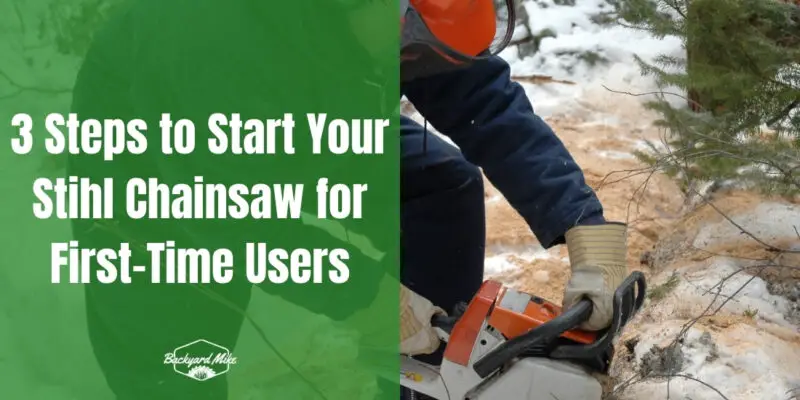To start your Stihl chainsaw, first, put on your safety gear and check for any obstacles. Then, place the chainsaw on a flat surface, secure the front handle with your foot, and make certain the chain brake is engaged. Set the Master Control Lever to choke, prime if needed, and pull the starter cord firmly until the engine fires. With these steps in mind, you'll be prepared to confidently start your chainsaw and get more insights.
Key Takeaways
- Wear necessary safety gear including eye and ear protection, gloves, and protective legwear.
- Place the chainsaw on a flat surface and engage the chain brake.
- Set the Master Control Lever to choke and press the throttle trigger lock.
- Pull the starter cord until the engine fires, using fast, forceful pulls.
- Ensure the workspace is clear of obstacles and maintain a safe operating radius.
Preparation and Safety Checks
Before you start your Stihl chainsaw, it's essential to focus on preparation and safety checks to guarantee a smooth and secure operation.
Begin by donning the necessary safety gear, including eye and ear protection, gloves, and protective legwear. This guarantees you're shielded from potential hazards.
Next, inspect your work area; clear it of obstacles and verify even ground to prevent accidents. Make sure to refuel at least 10 feet away from the chainsaw operation site to reduce the risk of accidents.
Verify the chain is properly fitted, sharpened, and tensioned. Check that the chain brake works correctly, and confirm bar and chain oil levels are sufficient. Stihl chainsaws are designed with innovative safety features to enhance user protection, ensuring a reliable performance during operation.
Ensure the air filter is clean, and the spark arrestor is in place.
Finally, make sure no one is within a safe radius during operation. Prioritizing these steps fosters a safe environment for all.
Starting the Chainsaw
To start your Stihl chainsaw efficiently, follow these essential steps carefully.
Begin by removing the chain guard and engaging the chain brake to prevent accidental starts. Place your chainsaw on a flat surface, ensuring the chain doesn't touch the ground. Secure a firm grip on the front handle, using your foot to steady the rear. Consider the chainsaw type you are using, as different types may have varying starting procedures.
Remove the chain guard, engage the chain brake, and secure your chainsaw on a flat surface for safety.
Set the Master Control Lever to choke for easy startup, pressing the throttle trigger lock. For chainsaws with a primer bulb, press it several times. Additionally, consider safety equipment such as gloves and eye protection before beginning the process.
Pull the starter cord slowly to feel resistance, then continue with fast, forceful pulls until the engine fires. If necessary, repeat until the engine starts.
Listen for engine sparks, adjusting the choke if needed. This approach aids in engine troubleshooting and chainsaw maintenance.
Final Adjustments and Pre-Work Checks
As you prepare for operation, verify all final adjustments and pre-work checks are completed for safe and efficient chainsaw use.
First, confirm your safety gear is secure—wear eye and ear protection, gloves, and protective legwear. Confirm the chain tension is correct, preventing accidents. Check the chain's sharpness and maintenance needs. Ascertain fuel and chain oil levels are sufficient. Wearing chainsaw chaps can prevent life-threatening injuries from chainsaw accidents, so ensure they are properly fitted. It is also essential to inspect the spark arrestor for any carbon buildup and clean or replace it if necessary, as operating the chainsaw without it is not recommended.
Clear your workspace of people and obstacles. Test the chain brake and lubrication by observing a trail of oil when running. Inspect and clean the air filter, secure all fasteners, and remove chain guards.
Adjust the master control lever and test the throttle trigger. Finally, verify the area is stable, free of electrical interference, and have emergency kits ready.
Frequently Asked Questions
How Do I Clean My Chainsaw After Use?
You've got this! Start your chainsaw maintenance by gathering cleaning tools like old paintbrushes and compressed air. Brush off debris, clean parts thoroughly, and reassemble carefully. Join the community of skilled chainsaw users who keep their tools in top shape.
What Type of Fuel Should I Use for My Chainsaw?
You should use unleaded petrol with a minimum 89 octane rating. Mix it at a 50:1 ratio with high-quality two-stroke oil. Avoid E15 and E85 fuels to keep your chainsaw running smoothly and efficiently.
How Often Should I Sharpen the Chainsaw Chain?
Did you know regular chain maintenance, like sharpening every 5 hours of use, can increase efficiency by 30%? Use precise sharpening techniques to guarantee your saw performs well, keeping you safe and part of the STIHL community.
What Is the Best Way to Store My Chainsaw When Not in Use?
You should embrace effective chainsaw maintenance by storing it in a dry, ventilated area. Use these storage tips: clean, oil, and secure your chainsaw. Avoid cement floors and guarantee it's away from sunlight to feel part of a responsible community.
How Can I Troubleshoot a Chainsaw That Won't Start?
When facing starting problems, check fuel issues first. Verify you've got fresh fuel and the right mix. Inspect the spark plug and air filter. Don't hesitate to consult your manual or seek advice from fellow chainsaw enthusiasts.
Conclusion
You've now mastered the art of starting your Stihl chainsaw. It's funny how something that seemed intimidating at first is just a series of simple steps. By following the preparation, starting, and adjustment procedures, you guarantee your chainsaw runs smoothly, making your tasks easier and safer. Remember, though, this newfound skill doesn't mean you're a lumberjack just yet. Always stay focused and prioritize safety. With practice, these steps will become second nature, enhancing both your confidence and capability.


